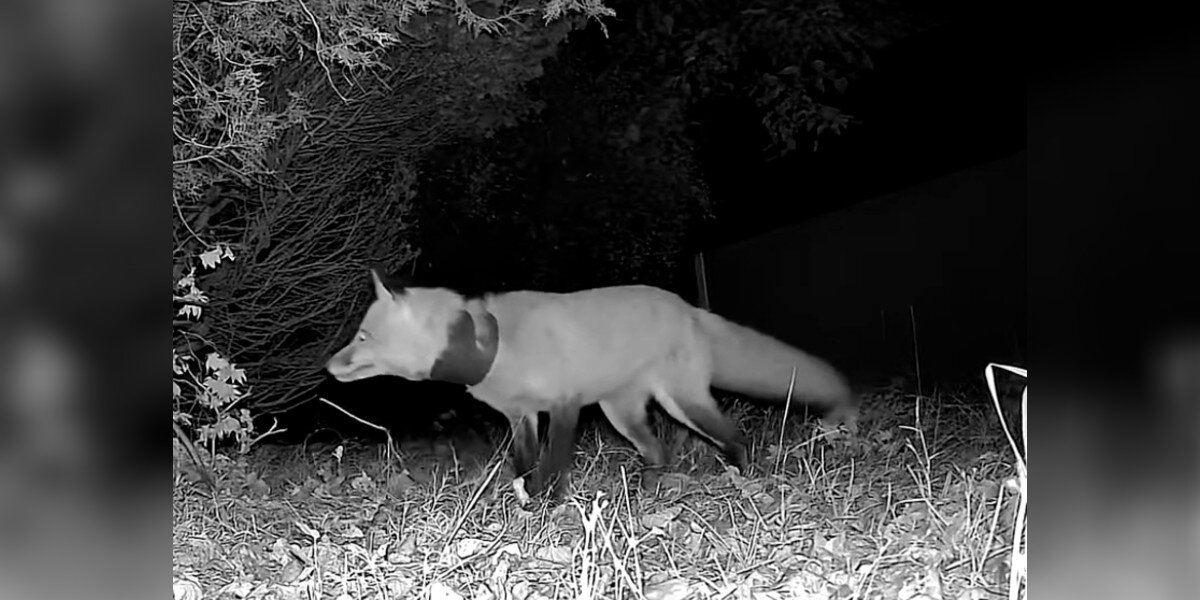Back in July, Julie Bernstein looked out her window in Pennsylvania and spotted an animal in trouble. A large fox roamed her backyard with a piece of tubing around his neck.
 Julie Bernstein
Julie Bernstein
Worried about his safety, she called Aark Wildlife Rehabilitation and Education Center (Aark) for advice and set up a camera to track his movements.
The tube appeared to have split into two pieces. The fox’s fur stuck out between them as he prowled Bernstein’s property.
 Julie Bernstein
Julie Bernstein
“The object around his neck was likely a section of drainage pipe,” Amanda Leyden, a licensed wildlife rehabilitator and clinic director at Aark, told The Dodo. “Small animals sometimes take shelter in these pipes, and a curious fox may stick its head inside to investigate or hunt, only to find itself stuck when trying to back out.”
Aark told Bernstein her best option would be humanely trapping the fox and bringing him into their facility.
First, Bernstein needed to set up a feeding station for the fox, whom she affectionately named Tubey, in an area he visited often. She documented Tubey’s movements with a trail camera.
Next, Bernstein placed a humane trap close — but not too close — to the food.
Over several weeks, Bernstein then inched the food closer to the trap every day, encouraging Tubey to follow his meal into the cage.
“Foxes are extremely intelligent and cautious,” Leyden said. “So this process took quite a bit of time and patience.”
Finally, in late October, nearly three months after Bernstein first spotted Tubey, he found himself caught in her trap. She immediately drove him to Aark for help.
 Aark Wildlife Rehabilitation and Education Center
Aark Wildlife Rehabilitation and Education Center
“Surprisingly, Tubey was in excellent condition,” Leyden said. “He had a beautiful, full coat and was a healthy weight of over 18 pounds. He was a very large red fox.”
Though in good health, Tubey was understandably distressed by his situation. The drainage pipe around his neck could not have been comfortable, especially after so much time. Being in a cage and surrounded by humans didn’t help.
 Aark Wildlife Rehabilitation and Education Center
Aark Wildlife Rehabilitation and Education Center
Aark’s team sedated Tubey, cut off the tube and gently examined his neck for injuries. Luckily, there were no wounds or irritation below his fluffy fur, just some ticks that the staff removed.
To be safe, they also tested for sarcoptic mange, a parasitic infection that the U.S. Fish and Wildlife Service says could be fatal if left untreated. Tubey’s test came back clean, and he was released back into Bernstein’s care.
 Aark Wildlife Rehabilitation and Education Center
Aark Wildlife Rehabilitation and Education Center
“Once Tubey woke up fully from sedation, he appeared noticeably calmer,” Leyden said. “He settled comfortably in his crate, alert but no longer panicked, which was a big change from his arrival.”
Leyden added, “Covering open drainage pipes with hardware cloth … and cutting up items like plastic rings can make a real difference. We often see wildlife tangled in packaging, bottles or containers that could have been safely discarded.”
 Aark Wildlife Rehabilitation and Education Center
Aark Wildlife Rehabilitation and Education Center
Bernstein took Tubey back to the area where she’d originally spotted him, sending him back home without the burden of a large drainage pipe around his neck.
Tubey hesitated for a moment, then bolted from the crate, ready to get back to the wild.
If you’d like to support Aark Wildlife Rehabilitation and Education Center, you can donate to their efforts or purchase items from their wish list via their website.  ‘Unusual’ Fox Too Friendly For The Wild Demands Belly Rubs From His CaretakersHe’s built a little differently …
‘Unusual’ Fox Too Friendly For The Wild Demands Belly Rubs From His CaretakersHe’s built a little differently …

